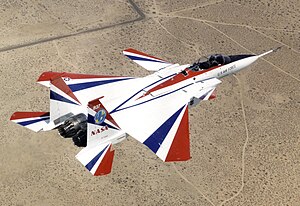|
McDonnell Douglas F-15 STOL/MTD
The McDonnell Douglas F-15 STOL/MTD (Short Takeoff and Landing/Maneuver Technology Demonstrator) is a modified F-15 Eagle. Developed as a technology demonstrator, the F-15 STOL/MTD carried out research for studying the effects of thrust vectoring and enhanced maneuverability. The aircraft used for the project was pre-production TF-15A (F-15B) No. 1 (USAF S/N 71-0290), the first two-seat F-15 Eagle built by McDonnell Douglas (out of 2 prototypes[2]), the sixth F-15 off the assembly line, and was the oldest F-15 flying up to its retirement. It was also used as the avionics testbed for the F-15E Strike Eagle program.[3] The plane was on loan to NASA from the United States Air Force. This same aircraft would later be used in the F-15 ACTIVE ("Advanced Control Technology for Integrated Vehicles") from 1993 to 1999, and later in the Intelligent Flight Control System programs from 1999 to 2008. While with NASA, the aircraft's tail number was 837.[4] The aircraft is now on display at Edwards AFB.[5] Design and development In 1975, Langley Research Center began to conduct sponsored programs studying two-dimensional thrust vectoring nozzles;[6]: 44 government and industry studies of non-axisymmetric two-dimensional (2-D) nozzles in the early 1970s had identified significant payoffs for thrust-vectoring 2-D nozzle concepts.[6]: 192 In 1977, Langley started a system integration study of thrust-vectoring, thrust-reversing, and 2-D nozzles on the F-15 with McDonnell Douglas. In 1984, the Flight Dynamics Laboratory, the Air Force Aeronautical Systems Division awarded a contract to McDonnell Douglas for an advanced development STOL/MTD experimental aircraft.[6]: 192 The aircraft used in the STOL/MTD program[7] has flown several times since the successful STOL/MTD program completion in 1991 that used thrust vectoring and canard foreplanes to improve low-speed performance. This aircraft tested high-tech methods for operating from a short runway. This F-15 was part of an effort to improve ABO (Air Base Operability), the survival of warplanes and fighting capability at airfields under attack. The F-15 STOL/MTD tested ways to land and take off from wet, bomb-damaged runways. The aircraft used a combination of reversible engine thrust, jet nozzles that could be deflected by 20 degrees, and canard foreplanes. Pitch vectoring/reversing nozzles and canard foreplanes were fitted to the F-15 in 1988. The canard foreplanes were derived from the F/A-18's stabilators.[8][9] Prior to 15 August 1991,[6]: 194 when McDonnell Douglas ended its program after accomplishing their flight objectives, the F-15 STOL/MTD plane achieved some impressive performance results:
The results of the STOL/MTD would help inform requirements for the Advanced Tactical Fighter program, which resulted in the F-22.[9] Further modificationsDuring the 1990s the same F-15 airframe (USAF S/N 71-0290) was further modified (canards and nozzles were retained) for the ACTIVE ("Advanced Control Technology for Integrated Vehicles") program in which the Pratt & Whitney Pitch/Yaw Balance Beam Nozzles (P/YBBN) and advanced control-logic programming were investigated; NASA acquired the plane in 1993 and replaced the engines with Pratt & Whitney F100-229 engines with P/YBBN.[10] In the ACTIVE configuration it was also used for the LANCETS ("lift and nozzle change effects on tail shock") program, in which computed supersonic shockwave parameters were compared to those measured in flight. The LANCETS flight tests ended in December 2008.[11] F-15 ACTIVE lasted from 1993 to 1999, with thrust vectoring demonstrated at up to Mach 1.95 on 31 October 1996. The aircraft would later be used in the F-15 IFCS (Intelligent Flight Control System) program from 1999 to 2008. The airplane was also used for the Space-Based Range Demonstration and Certification project under the Exploration Communications and Navigation Systems program (SBRDC/ECANS) from 2006 to 2007, High Stability Engine Control (HISTEC) program, and High-Speed Research Acoustics in 1997.[citation needed] Specifications (F-15 ACTIVE)  Data from NASA.[8] General characteristics
Performance
In popular culturePatlabor 2: The MovieIn a scene from the 1993 animated film Patlabor 2: The Movie, set in the year 2002, a flight of three rogue F-16Js (flight "Wyvern") are intercepted by two pairs of a semi-fictional F-15J Kai+ (flights "Wizard" and "Priest"), which feature some of the STOL/MTD's airframe additions. Ace CombatNumerous entries in the Ace Combat video game series feature the F-15 STOL/MTD as an unlockable player aircraft, and has also been the aircraft of choice for some antagonists. In Ace Combat Zero: The Belkan War, the Sorcerer Team flies eight F-15 STOL/MTDs. A fictional modernized derivative, the F-15S/MT Eagle+, is used by Abyssal Dision, main antagonist of Ace Combat 3: Electrosphere. Project WingmanThe plane appears in the Project Wingman video game under the name F/S-15. It is used by allied and enemy units alike and can be unlocked by the player. See alsoRelated development Aircraft of comparable role, configuration, and era Related lists References
External linksWikimedia Commons has media related to F-15S/MTD.
|
||||||||||||||||||||||||||||||
